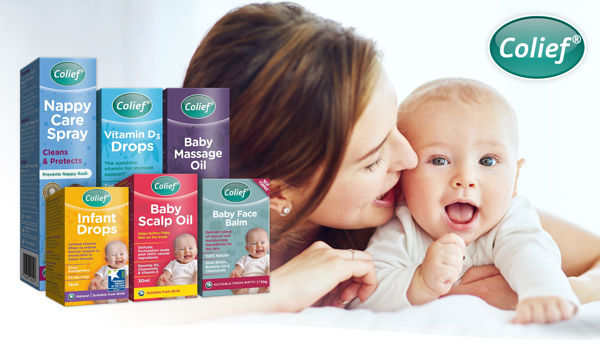It is not unheard of for parents to feel like they have the whole parenting of a newborn thing sussed, then BAM, along comes colic. Despite it affecting up to 1 in 5 babies, it can still come as quite a surprise and can feel quite isolating. Having a baby that is crying for hours at a time can be frustrating and just a little overwhelming.
If your baby cries excessively and ticks the perfect storm of 3: cries for 3 hours a day, at least 3 days a week, and has done so for three weeks, following a trip to the doctor, and being given a clean bill of health, it’s likely they are suffering from colic.
A newborn will usually cry for an average of 2 and a half hours per day total, and this peaks at around 8-weeks of age.
Does My Baby Have Colic?
Do they:
- Cry to the point they are red in the face?
- Arch their back?
- Pull their knees up to their chest?
- Clench their little fists?
- Cry for really long periods of time?
If so, it’s likely they have colic. But don’t worry, it’s quite common and is treatable.
What Causes It?
Trapped Gas
Generally, the first question to ask. - "Are they being winded?" And "are they taking in lots of air during their feeds?" If so, this could be getting trapped in their tummies causing discomfort and bloating. When they are born, babies have an immature digestive system, which is fine as this develops over time, but in the early weeks, this can mean that the milk takes quite some time to digest. By 3 or 4-months of age, this should start to improve, but it does take time.
The Fourth Trimester
Pregnancy is broken down into 3 trimesters whilst your little one is getting ready for the outside world. However, even when they are earth-side, they are still very much dependant on their mother to continue this development. Known as the '4th trimester', the 3 months following birth can be a little overwhelming as they experience the wonders of the world.
Everything has changed for your baby. They have spent the past 9 months in a dark and cosy womb and are now facing the bright sunshine and clear sounds of earth. Babies often experience a sensory overload, resulting in them being a little fussy and reluctant to settle outside of the arms of their mother.
Over-stimulation
Ever heard of the 'witching hour?' A seemingly happy baby suddenly turns up the volume and goes from nought to screaming in 5 seconds flat and then stays there for the next few hours. This can feel like everything you are trying to do is rejected and you start to doubt your abilities. Don’t do that! You are doing great.
One of the key things here, is to look out for your baby’s cues and try to make sure that they are getting enough sleep time during the day. Dumb down stimulation in the run up to the usual time of baby being unsettled - one sign is baby not making eye contact and looking away.
Cow’s Milk Protein Allergy
Otherwise known as CMPA, a cow’s milk protein allergy is your baby’s gut reacting to the milk proteins, whey, or casein, in their milk. Babies can be miserable and the days for parents can be long and anxious, as your baby may cry for most of the day.
Symptoms of a cow’s milk protein allergy can include:
- Eczema
- Mucus in poo
- Constipation
- Wheezing when breathing
- Vomiting
- Blood in poo
The only way to take away baby’s discomfort, is to take away the dairy element of their feed. If you are breastfeeding, try eliminating dairy from your diet and if you are formula feeding, you can get a prescription for hydrolysed formula milk from your GP.
Delayed Sensitivity to Cow’s Milk
In some cases, your baby can get along well with their milk in the beginning but still seems to suffer with bloating and trapped wind. This is often coupled with being a little constipated or fussy when feeding. This is not necessarily an allergy but can be because of your baby having an immature digestive system and therefore is not able to digest the milk efficiently.
Cutting dairy out of your diet (if breastfeeding) may reduce these symptoms in your baby or, if formula feeding you could try a comfort milk.
However, keep in mind that you do sometimes swap colic symptoms for constipation as the milk is a little heavier to reduce reflux. The proteins in comfort milks are smaller and therefore place less pressure on baby’s digestive system.
Reflux
Having a baby that is sick after every feed can be quite stressful. Babies are born with an immature digestive system which results in the oesophageal sphincter not closing as firmly as it should. In some instances, this allows all a baby’s feed to come back up and can cause discomfort for baby. Baby will often arch their back and cry excessively. One thing that can help is holding baby upright for longer after feeds to allow the milk to digest. As baby gets older and they can sit upright for longer periods, the signs and symptoms of reflux often diminish.
Tongue Tie
Another thing to consider is whether your baby has a tongue-tie (also known as 'ankyloglossia'). A tongue-tie is a small strip of skin that connects baby’s tongue to the bottom part of the mouth, known as the 'lingual frenulum'. In many cases, this, therefore, doesn’t cause a problem, but it can hinder baby’s ability to move their tongue properly and therefore cause issue when feeding. Babies with a tongue tie often struggle to latch on to the breast well and tend to take in more air. Mums often suffer more with sore nipples too.
Your baby will often take in much more air than if there wasn’t a tongue tie. This can result in more trapped wind and colicky behaviours. In some cases, it is recommended that the tie is snipped to divide the skin and allow freer movement of the tongue and improve feeding. Tongue-tie can however (though very rarely) grow back, so it's worth checking regularly if you're having issues with their latch or feeding.
Colic Remedies
Have a baby with colic? Then you’ll probably have been desperately trying to find a solution. Luckily, there are lots of different remedies out there, some new, some as old as the hills. The right remedy will depend on the cause of the colic, and it is important to remember that there may not be a total solution, but there are things that you can try.
Infacol, gripe water, and colief are traditional products that can help. However, it is worth noting that many products do contain chemicals and as such there has been a recent move towards more homeopathic remedies.
Chamomilla granules, nat phos, and infant probiotics are often used instead. When making your choice, it is so important that you ensure products are well researched and tested and pass as suitable for infants.
Breastfeeding mothers could also enjoy a nice cup of chamomile tea which can help to calm baby via your milk. Adding fennel or peppermint to the mix could also help to settle sensitive little tummies.
Baby Massage
As covered in our 'Developmental Baby Massage' blog, touch is so important for babies as they are still developing the ability to communicate through other methods. Making gentle stokes, massages and cuddles are babies’ first language. As well as being a comfort to babies, it can also really help with any digestive problems and encourage the tummy to relax and release any trapped wind.
Stroking baby’s tummy in a clockwise direction, directly targets the digestive system and encourages movement within to ease discomfort. In addition, the love hormone, 'oxytocin' is released alongside the body’s natural pain killing hormone, 'endorphins'. Massage really is a win-win.
Back Inside
Your baby never felt more secure than when they were in the womb, so recreating some of those sensations may help to calm baby. Wearing baby in a sling, gentle rocking and swaying, the playing of white noise, or the sound of heartbeats and swaddling may also be a source of comfort for your baby.
Baby Wearing
Babies like to be cuddled! So, using a carrier or sling can be an ideal way to comfort your baby whilst moving around. The closeness gives your baby the sound of your rhythmic breathing and your heartbeat at the same time - just as they had in the womb. This calm and comforting position can trigger your baby’s 'parasympathetic nervous system' to kick in and trigger the 'rest and digest' instinct in your little one. This slows down baby’s heart and encourages the digestion of food. In addition, the nature of the carrier encourages baby to be in an upright position and therefore doubly aids digestion. All that gravity keeps milk where it should be and can reduce those reflux symptoms too.
Colic Holds
We have all held a baby and bounced and rocked them in a bid to settle their cries. These movements mimic the womb and are often really comforting to baby as they are transported back to the rhythmical movements of the womb.
'Tiger in the tree' hold can be great for babies as it can help to provide pain relief to any tummy discomfort.
With your baby on their tummy across your arm, their head should be supported by your inner elbow. Rub your baby’s tummy and gently rock to give a calming effect by reducing stimulation.
If you need any help with diagnosing or treating colic, talk to your GP or health visitor who may be able to advise on your options.
If your baby is suffering from Colic, why not consider signing up for The Honest Midwife's Colic & Reflux workshop? Use YBC20 at the checkout to get 20% off.









